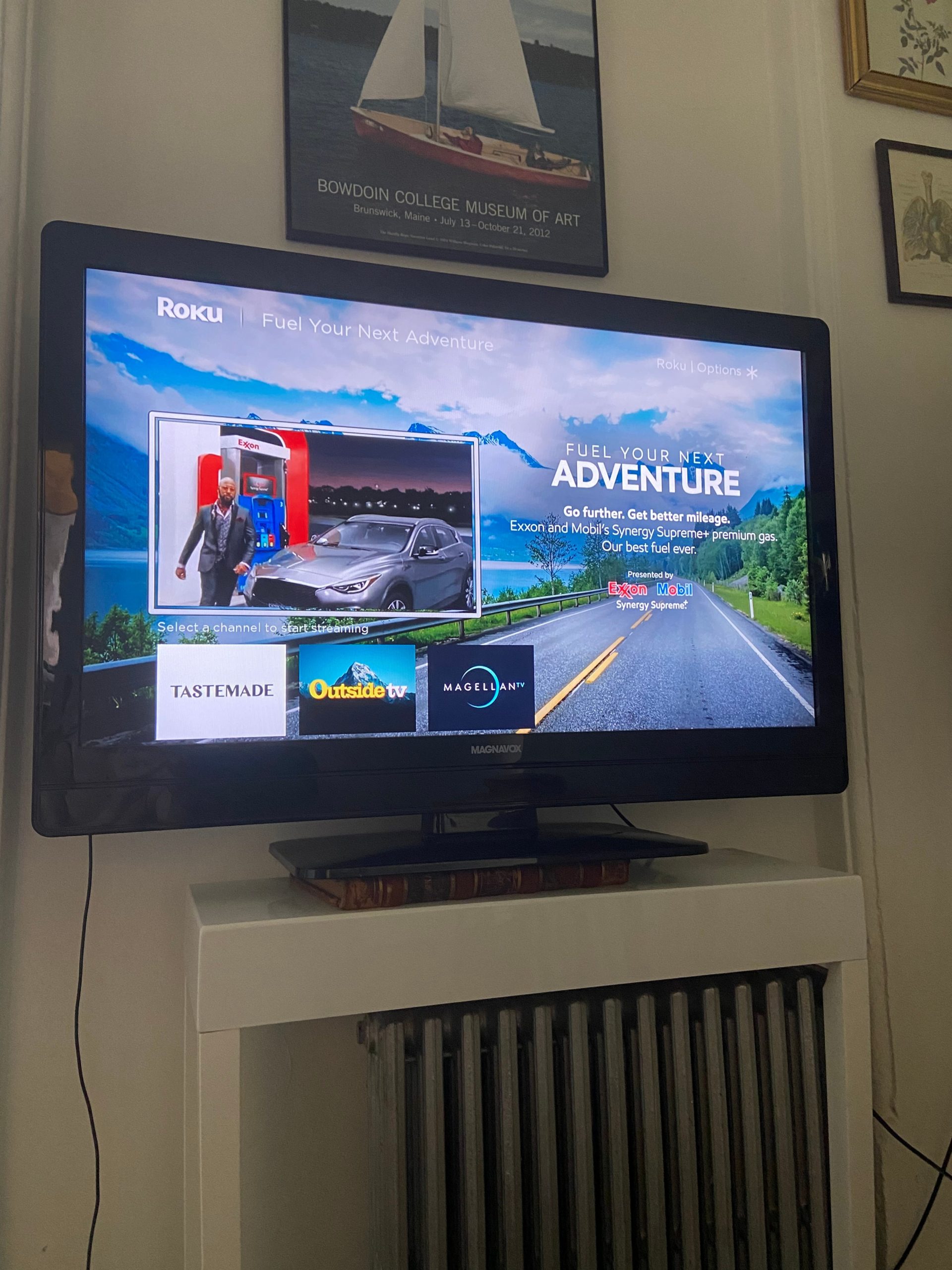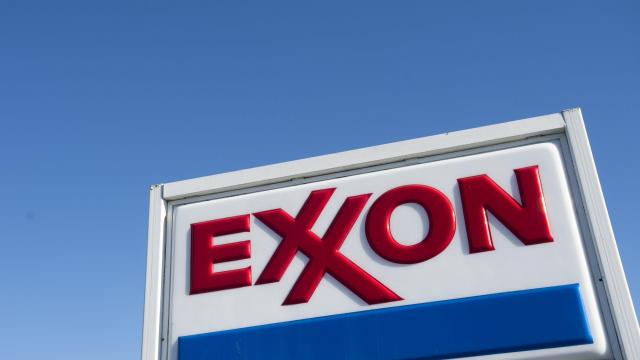One Saturday night in June, I turned on my TV and fired up Roku, my streaming platform. I was ready for a night in, bopping between Netflix, Hulu, HBO Go, and the myriad other channels available on the platform in search of the perfect binge watch.
A familiar — and unwelcome — logo popped up on the screen: ExxonMobil. I brushed it off at first; Big Oil was not going to get between me and my rewatch of Succession. But I kept seeing Exxon’s ad floating across my TV in subsequent weeks. It turns out streaming services are opening up a whole host of new advertising opportunities for Big Oil.
I first spotted the ad on Roku’s screensaver — a cityscape graphic the service uses when the TV is on but at rest, complete with “billboard” advertisements that float gently across the screen. It appeared again a few days later in Roku’s main menu, in the sidebar alongside where users can select channels. Selecting the ad took me to a separate, Exxon-branded screen.
The background was an improbably beautiful mountain scene, the likes of which fossil fuelled-fires are currently burning through. It was titled “Fuel Your Next Adventure.” There, I was treated to an ad for Exxon’s Synergy gas and offered a choice of three different streaming channels to check out: Tastemade, a food and travel channel; Magellan TV, which offers documentaries; and Outside TV, the streaming arm of the outdoors-focused magazine brand.

Seeing the Exxon logo continually popping up on my TV screen was jarring for me, an innocent climate reporter just trying to stream 90 Day Fiancé in my off time, so I reached out to Roku to figure out what the heck it was that I’d just seen. A spokesperson told me that the page was a “streaming guide” — a way a brand can work with Roku to promote itself on the service by suggesting content their target audience might like. The spokesperson sent me a post on the company’s advertising blog that details some of the types of advertising companies can buy on the platform.
“If you want to recommend content to viewers, offer a guide of top streaming channels that your audience will most likely want to watch,” the blog post says about the “streaming guide” example. It uses a screenshot of a collection of food and cooking channels put together by egg producer Eggland’s Best for a “Home Cooking For The Holidays” collection: the Food Network, Eater, and Food52. (Mmm, eggs.)
It’s a great idea for a brand to tap into Roku like this. The platform is the U.S.’s most popular smart TV streaming service by a big margin, dominating 38% of the market share at the end of 2020, besting options like Amazon Fire and Apple TV. Roku boasted more than 51 million accounts at the start of this year (14 million of which, the company said, were added in 2020 alone).
As Roku’s blog post explains, the enormous amount of content at our fingertips means that viewers spend a lot of time on that home screen just trying to figure out what to watch: The average user, surveys have shown, takes seven minutes trying to decide what to stream, and more than half of viewers turn on their TV without knowing what they actually want to watch. (Guilty.) It’s pretty clear that as users move away from live TV and onto different streaming platforms, there are lots of opportunities for these platforms to sell new kinds of space for companies to plop an ad in front of viewers browsing for their next binge watch.
The choice of channels reflected in the Exxon Roku ad — science documentaries the outdoors — paint a specific picture of the audience Exxon is trying to reach: people interested in travel, culture, and science who care about the environment. It fits with a pattern of other fossil fuel company advertising Earther has tracked recently from Shell tapping Instagram travel and science influencers to promote gas to reality host and faux-man-of-the-people Mike Rowe’s new Discovery+ show being propped up by the American Petroleum Institute. (Ads for Rowe’s show have also popped up on my Roku, so maybe fossil fuel companies think I’m in their audience zone. Which, lol.)
It was jarring to see Exxon using Outside, a company focused on the splendor of the outdoors, and Magellan TV, which has a huge selection of documentaries on science and nature, to advertise itself. Did these companies know about the Exxon deal — or even get a cut of it? Emails to Roku as well as Outside TV and its owner, Pocket Outdoor Media, went unanswered. But a representative from Magellan TV’s PR group said in an email that “Roku controls all if [sic] its own advertising initiatives which are strictly between Roku and its advertisers” and any questions about the Roku guides should be sent to the streaming company.
“MagellanTV is not a party to these deals in any way,” they wrote. “MagellanTV’s revenue is derived solely from customer subscriptions to its documentary streaming platform.”
The company confirmed in a subsequent email that they had no input on or participation in the ad — which marks a pretty serious departure from how advertising usually works. In the past, TV channels like Outside or Magellan would work directly with a company like Exxon on deals like this.
The addition of a third-party platform that controls how viewers reach both the advertiser and the brand in question significantly changes this equation, though. Roku is the one connecting Exxon to brands like Outside and Magellan, allowing the oil company to create a connection between itself and outdoorsy viewers. This is despite the fact that Exxon is one of the largest corporate polluters in history that has also spent decades denying science and stonewalling action to address carbon pollution.
The role of advertising in promoting fossil fuel companies has come under fire in recent months, with activists calling for public health warnings to be attached to ads from Big Oil and advertising companies distancing themselves from working with fossil fuel companies. (After Earther reported on advertising company Carmichael Lynch’s role in creating an ad campaign for Conoco, for instance, the company changed its case study to remove a line bragging about how much gas the campaign had sold.)
In light of all this pressure, putting an ad on a Roku screen is a pretty creative move. A Roku promo, in essence, helps Exxon clean up its image by using brands that promote science and the outdoors, while not allowing those brands themselves any input. It illustrates the game of whack-a-mole we’re all playing as Big Oil is racing to find ways to preserve its influence and buff its grease-stained reputation. The industry will always dream up new ways to advertise its product — and find ways to reach us at our most vulnerable, like on our couches gearing up for a good old-fashioned binge watch.
